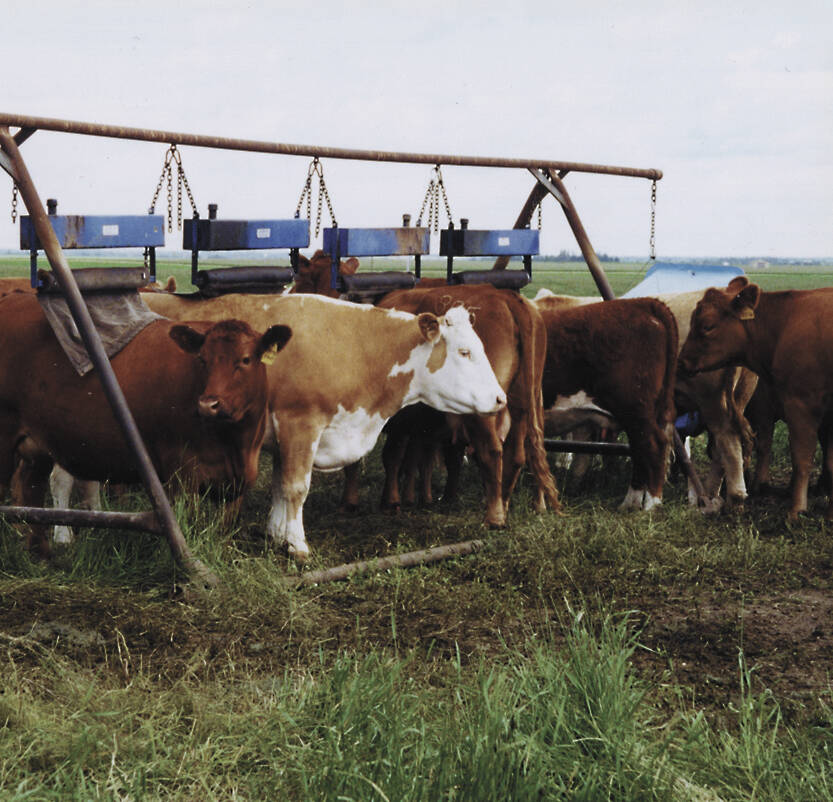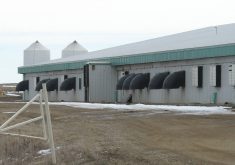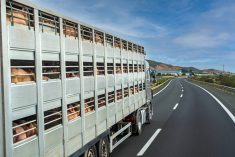Poor trailer design and transportation stress are killing pigs and costing the pork industry millions of dollars in penalties, meat quality downgrades and failed welfare audits, according to research by a federal scientist.
Luigi Faucitano, a research scientist with Agriculture and Agri-Food Canada, says the pre-slaughter period — which includes the journey from farm to abattoir — currently has gaps in best practice.
There are a number of financial hits associated with those gaps, Faucitano said during a recent virtual event hosted by AAFC’s Sherbrooke Research and Development Centre in Quebec.
Read Also

Shifting standards on cattle parasite control
Parasite product resistance has more farmers and veterinarians thinking differently about how to control issues like lice or worms.
Truckers face penalties up to $4,000 when more than three or four pigs arrive dead at processing plants. Poor meat quality from stressed animals forces processors to sell depreciated pork, while carcass lesions linked to issues during transport can reduce value by up to six per cent.
WHY IT MATTERS: Animal transportation is increasingly under scrutiny by animal rights groups, but a less stressed animal also gives the pork sector better outcomes on meat quality and profit, the researcher argues.
There’s also the matter of public perception. Canada’s pork sector has spent considerable effort on their public trust and sustainability files.
A 2021 Quebec telephone survey found consumers were very reluctant to believe that the animals are well-transported, Faucitano noted.
Consumer concern focuses on food and water deprivation, he said, leading to animal rights demands for transportation times to be cut to less than eight hours.
“That’s something that is really … very worrisome to them,” he said.
As of 2022, the Canadian Food Inspection Agency (CFIA) started enforcing its new animal transportation standards. The new rules came into force in 2020, but industry was given a two-year grace period to adjust, in which federal efforts focused on awareness and education.

Those rules dropped the maximum time livestock could be on the road without food, rest and water. The top uninterrupted trip length for pigs and other single-stomached livestock species dropped to 28 hours, down from 36. After that, livestock would need to be given at least eight hours off the truck, up from the previous five. Transporters were also required to have a contingency plan in place for each trip.
The CFIA said the new rules gave more guidance on animal welfare issues during transports, such as weather protections, space during transport and ventilation. The rules also classified livestock between those fit for transportation, those that need special provisions (animals that are lame, blind, certain injuries such as broken tails, etc.) and those that are unfit to transport (fractured limbs, unable to stand without help, suffering fever or dehydration, etc.).
Discomfort during transport
Transportation often isn’t comfortable for the pigs, Faucitano said. His research found that temperatures ranged from -25 C to 2 C in winter and from 9 C to 40 C in the summer.
“This temperature range actually exceeds the thermal comfort zone of pigs,” he said, adding that pigs struggle at temperatures above 25 C and below 10 C.
Other sources of discomfort come from noise, vibration and gases.
Infrared scanning can show the biological response of pigs to those stresses, he noted. Such tests register elevated body temperatures after transport.
And while other livestock species face the same stresses and pigs tend to spend more time on the truck — about 65 per cent of pigs are moved during different production phases — pigs have unique vulnerabilities to transport stress, said Faucitano.
“When we compare this type of species to the other meat species, we see that pigs actually present the higher mortality rate compared to the cattle, to goats and sheep,” he told attendees, adding that young pigs are at particular risk.
“(They) are … more prone to die during transportation, because they are more vulnerable to these types of things, especially in the summer, because they are very sensitive to heat stress.”
Trailer design a critical factor
One Canadian epidemiological study of three million transported pigs found transportation factors contributed to 31 per cent of mortality rates, Faucitano said. Vehicle design was one key issue identified.
His research looked at the “potbelly trailer,” a three-deck design with internal ramps. The design allows for high capacity, making them popular with truckers. According to Faucitano, however, there are also animal welfare concerns.
In a study for the Prairie Swine Centre in the late ’00s, researchers looked at how transport conditions translated to physiological pig response in both winter and summer. They found significant differences, depending on which compartment of the potbelly trailer pigs wound up. The bottom-front compartment of those trucks required two ramps to get to, was hotter, led to higher heart rates during transportation and those pigs had more meat quality issues. Pigs in upper compartments had higher heart rates and body temperatures during loading and waiting on the farm, while the compartments were cooler.
Those in the middle level, which had no ramps, had lower heart rates while on the truck and fewer biological stress indicators (as measured by blood tests) when they reached their destination.
Results out of Eastern Canada in the same study, which used both a potbelly trailer and double-decker trailer, found that the double-decker — which had no internal ramps — had fewer pigs slipping, balking or falling, and temperatures were more consistent.
“In the long run, alternative designs should be sought, such as trucks including hydraulic lifts and/or minimal ramps, to minimize handling stress at loading and unloading,” the authors said.
Faucitano’s work put hydraulic systems to the test and found lower mortalities.
The lower ceiling in more modern vehicles remains another ongoing research gap, Faucitano said.
Ventilation problems
Even with design improvements, ventilation remains a critical challenge, Faucitano said. Traditional trailers only get airflow when moving, creating dangerous conditions during loading and unloading.
“So if it’s 30 degrees outside, the pigs were feeling 38, 39, up to 40 degrees inside. So very, very warm.”
His team tested mechanical ventilation solutions, including misting systems at slaughter plants that were ventilated and animals misted for ten minutes upon arrival. Results showed that temperature dropped by three degrees. However, even sophisticated ventilation modifications failed to make much improvement on the conditions inside the trailer.
“The design itself inside doesn’t help. To … make this type of cooling system efficient enough,” the researcher said.
Load density and rest
Reducing the number of pigs per load significantly improves conditions. The more pigs inside the trailer, the hotter the temperature will be, Faucitano said.
That, however, removes some of the production benefit underpinning the popularity of the trailer.
At slaughter plants, the lairage rest period, which is designed to let pigs recover from transport stress, requires careful management, he added. Two to three hours is recommended, but his research found varying practices from less than one hour up to 18 hours, depending on the season.
Too little rest prevents recovery. When given just 35 minutes, pigs did not recover to optimal heart and respiration rates, and body temperatures did not return to base level.
“It was not enough,” Faucitano said.
Too much time, however, creates new problems. Unfamiliar pigs may fight causing skin lesions that damage carcass value.
Back to school
More driver training may be a partial answer, the researcher said.
The driver’s behaviour was a contributing factor in eight per cent of transportation mortalities, he reported.
Solutions will require industry-wide changes that address transportation space allowance, body weight, ambient condition and travel time, Faucitano told attendees.
















